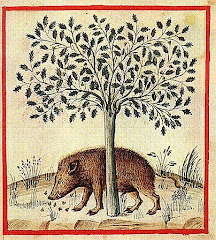 This is one of the easiest and most readily available natural dyes to experiment with. It produces beautiful sunny yellows when combined with alum and the only disadvantage with it is that it tends not to be so colour fast and will fade in sunlight.
This is one of the easiest and most readily available natural dyes to experiment with. It produces beautiful sunny yellows when combined with alum and the only disadvantage with it is that it tends not to be so colour fast and will fade in sunlight.For this one I boiled up 100g of white onion skins in around 5 litres of water. After about half an hour, I thought I'd be clever and put in 50g of alum mordanted Hampshire wool along with the same of un-mordanted Hampshire wool so that I would be able to see the difference the alum made afterwards. I separated the two types of wool by tying them up in muslin.
An hour and a quarter later both had turned a bright, sunny yellow. There was no noticeable difference between them which just goes to show it takes very little alum (the residue from one lot of wool affecting the other) to achieve the desired effect. This phenomenon was confirmed to me a day or two later by a far more experienced dyer than myself.
So much for a fair test, it seems if I want to compare the effects of mordants I'll have to use separate dyebaths which can alone cause huge variations in the colour obtained. But never mind, this was never meant to be about doing a fair test anyway.
Later, once I'd spun the wool, it was just possible to detect a difference in the two colours, but nothing worth mentioning really. The completed hank is the mordanted version and the stuff on the bobbin is unmordanted - it's just a tiny bit less acid in tone.
 In a later experiment, which I won't detail to much, I tested the effects of acids and alkalis on onion dyed wool. Adding acetic acid first and then a load of bicarbonate of soda, I alternated a few times just because it was so exciting to see it all bubbling up the way it does (honestly, they should teach this stuff at school and then you'd get a few more kids taking sciences at A levels).
In a later experiment, which I won't detail to much, I tested the effects of acids and alkalis on onion dyed wool. Adding acetic acid first and then a load of bicarbonate of soda, I alternated a few times just because it was so exciting to see it all bubbling up the way it does (honestly, they should teach this stuff at school and then you'd get a few more kids taking sciences at A levels).But no change of colour was apparent either way and I soon gave up and set about rinsing this last batch. As is so often the case, this latest experiment taught me another lesson - never attack your wool with too many bubbles of the hot water, acid or alkaline variety! I ended up with the most impressively felted lump of bright yellow and utterly useless wool that I've ever achieved so far.
 Finally, to show you how wonderful onion can be when done well, here's a piccy of an onion skin and indigo bag made for me by my mother a couple of years ago. It has faded a bit, but you'd only notice if you scrutinised it carefully. I believe the varied tones were achieved by dyeing three different shades of wool - white, light grey and medium grey. This technique is always a good one for creating exciting and harmonious combinations.
Finally, to show you how wonderful onion can be when done well, here's a piccy of an onion skin and indigo bag made for me by my mother a couple of years ago. It has faded a bit, but you'd only notice if you scrutinised it carefully. I believe the varied tones were achieved by dyeing three different shades of wool - white, light grey and medium grey. This technique is always a good one for creating exciting and harmonious combinations. And of course, why do I want to take onion with me to the Smithsonian Folklife Festival? Apart from being so effective and obtainable, it's also one of the best illustrators of medicinal pigments around. Onion is full of flavonoids and is particularly high in the flavonol quercetin.
And of course, why do I want to take onion with me to the Smithsonian Folklife Festival? Apart from being so effective and obtainable, it's also one of the best illustrators of medicinal pigments around. Onion is full of flavonoids and is particularly high in the flavonol quercetin.Quercetin is found in significant quantities in onions, apples, tea, red grapes, citrus, dark green leafy vegetables, broccoli, tomato and a range of berries, especially red ones.
Studies have shown quercetin and similar flavonoids to be effective in reducing the incidence of heart disease, heart attacks and stroke. As with many flavonoids, quercetin helps reduce capillary fragility which is often associated with high blood pressure, varicose veins, chilblains and bruising.
The icing on the cake is a 1993 study conducted in Holland which showed an inverse relationship between mortality from heart related diseases and flavonoid intake. Of the 805 male subjects aged between 65 and 84 years of age, the most prominent sources of flavonoids were from tea, onions and apples - all of which contain significant quantities of quercetin. Other potentially relevant substances found in these foods include the flavonoids kaempferol and myricetin as well as certain tannins.
So, for a healthy heart, eat yellow!




















No comments:
Post a Comment